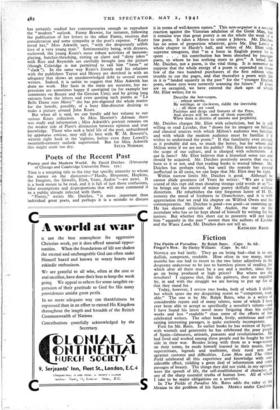Those Laurels . Again
Keats. By'Betty Askwith. (Collins. I2S. 6d.)
"To add another to the long list of books on Keats seems demand, if not an excuse, at least an explanation." This is ho Amy Lowell introduced her detailed, two-volume life of poet in 1924. Her explanations were new material and twentieth-century outlook. Let them pass. Since that perform ante we have been fairly swamped with Keatsiana. With th exception, perhaps, of Joan of Arc and Napoleon, no famou figure has been more sedulously and exhaustively pursued. IV have had Keats' Craftsmanship, Keats' Shakespeare, Keat Anatomical Note Book, Keats as Doctor and Patient ; Mr. Bust Forman's definitive edition of the letters, Professor Garrcd' final edition of the Poems (not to mention Mr. Middleto Murry's, along with his Studies and his Keats and Shakespeare' a Frenchman's biography, an American's autobiography corn piled from the letters, the publication of Charles Brown's life his friend, Fanny Brawne's letters to Fanny Keats, a life of th latter Fanny . . . and then Miss Dorothy Hewlett wrote it Adonais in case we needed a biography of Keats. This b no means exhausts the list. The subject has been searched a scrutinised as diligently as a suspect traveller at the, Custom Now comes Miss Betty Askwith. Explanation? Excuse? Th are to be found on the dust cover ; when that has vanished shall have to concoct some from the work itself. Miss Askyo had planned to write it from her early childhood. Meanwhil she found all other biographies too sentimental or too dry- What is to be said, then, for this latest version of a farni tragic life? First, it is written, presumably, for those who ha still managed to miss their Keats, and wish to read a true interesting story. The author's independence of first-h research gives it a merciful freedom from those detailed not and intricate discussions which, to the common reader, make biography hard-going. A writer's solid work is usually betray in his appendices. Miss Askwith's appendices are made mainly of quotations. That brings us to the second point: sb has certainly studied her contemporaries enough to reproduce the " modern " outlook. Fanny Brawne, for instance, following the publication of her letters to the other Fanny, receives due consideration and some sympathy at the poet's expense. "Keats loved her," Miss Askwith says, " with the desperately selfish love of a very young man." Sentimentality being, with dryness, eschewed, the young Keats's more robust activities of bassoon- playing, butcher-thrashing, rioting on claret and " dirty jokes " with Rice and Reynolds are carefully brought into the picture (though Coleridge is not permitted to call him " loose " or " slack "). In the same way Keats's friends and his relations with the publishers Taylor and Hessey are sketched in with an adequacy that shows an unacknowledged debt to several recent writers. Indeed, it is unfair to suggest that Miss Askwith has done no work. Her facts in the main are accurate, her ex- pressions are sometimes happy if unoriginal (as for example her comments on Beauty and the Grecian Urn); and by giving long extracts from the letters and even quoting such poems as " La Belle Dame sans Merci " she has pre-digested the whole matter for the benefit, possibly, of a busy film-director desiring to make a picture around John Keats. But when all is said, we can hardly add her volume to our serious Keats collection. In Miss Hewlett's Adonais there was study and information ; Miss Askwith's portrait remains on the weaker side of Plato's distinction between opinion and true knowledge. Those who seek a brief life of the poet, unburdened by apparatus criticus, may still d3 best with W. M. Rossetti's, written right back in the 'eighties, before even Amy Lowell's twentieth-century outlook supervened. But for Miss Askwith































 Previous page
Previous page